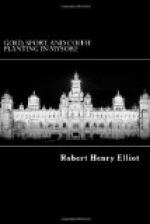It is of course very important to select a good site for the nursery, and a ready command of water is essential, as it is both costly and unsatisfactory to carry to the beds even a short distance, and the aspect should, if possible, be northerly, as in that case very little shading is required if the ground is on a slope, as, if a line of trees is left at the head of the slope, a large amount of lateral shade will be thrown on to the beds. Next to a northern an eastern aspect, if the land is low-lying, with a hill or sloping land rising rather abruptly behind it, is by no means a bad situation, as the sun will be entirely off the land early in the afternoon. Should the planter unfortunately have to fall back on a southern aspect, this may be aided by leaving forest trees rather thickly on the western side of the nurseries so as to shield it from the afternoon sun, or a line of casuarinas may be planted on the west, and also on the southern side, so as to cast lateral shade on the nursery. A western aspect is to be deprecated, in consequence of the scorching heat of the afternoon sun.
There is a common idea, which I myself once shared, that it is always best to have your nursery on new land, but this is really not at all necessary if you renew your land by carting on to it top soil from the jungle, or even a mixture of any fresh soil that has not been trampled upon, and which has been mixed with cattle manure and some bone-meal. I consider it most important to retain the same site for the nursery, because, by growing casuarinas to cast lateral shade on it, you can ultimately dispense with shading the




